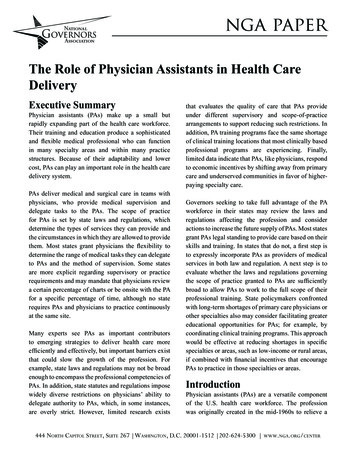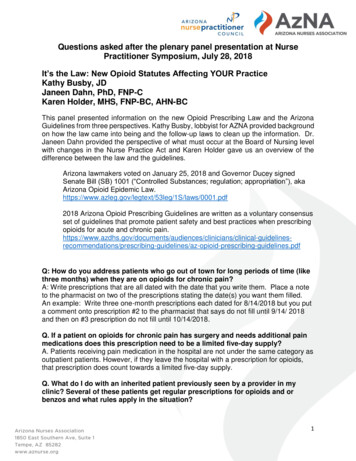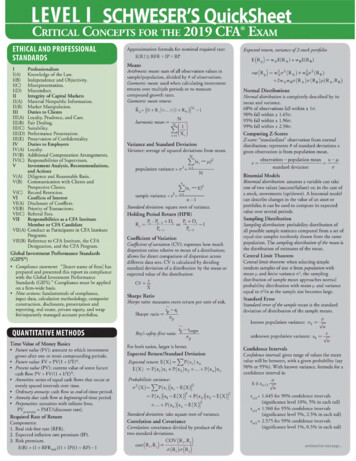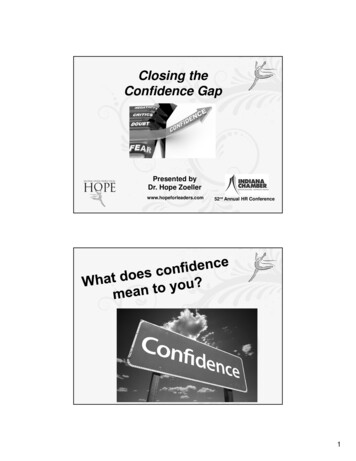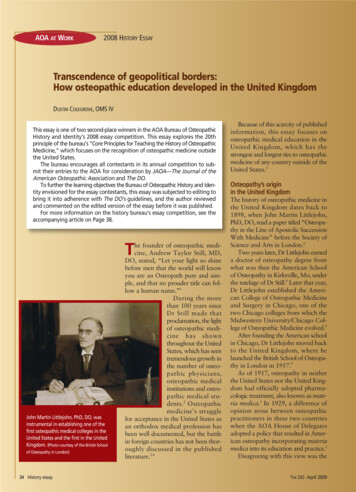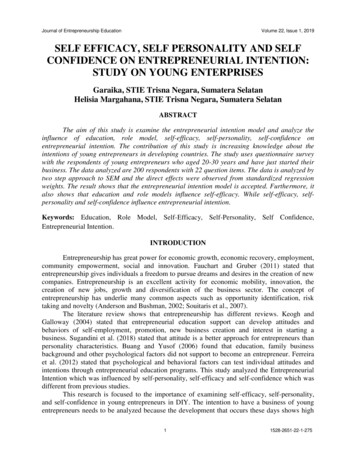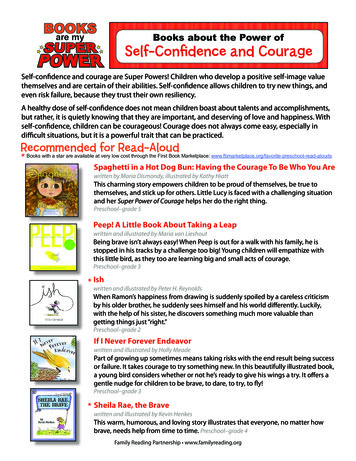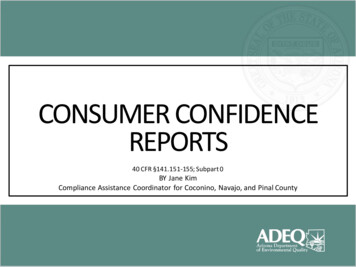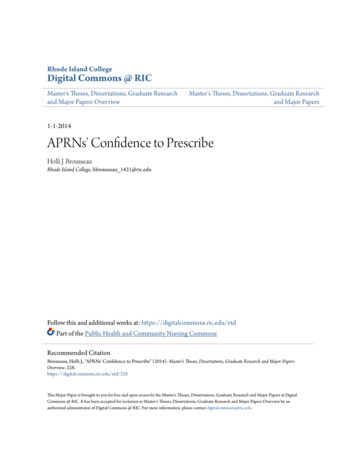
Transcription
Rhode Island CollegeDigital Commons @ RICMaster's Theses, Dissertations, Graduate Researchand Major Papers OverviewMaster's Theses, Dissertations, Graduate Researchand Major Papers1-1-2014APRNs' Confidence to PrescribeHolli J. BrousseauRhode Island College, hbrousseau 1421@ric.eduFollow this and additional works at: https://digitalcommons.ric.edu/etdPart of the Public Health and Community Nursing CommonsRecommended CitationBrousseau, Holli J., "APRNs' Confidence to Prescribe" (2014). Master's Theses, Dissertations, Graduate Research and Major PapersOverview. 228.https://digitalcommons.ric.edu/etd/228This Major Paper is brought to you for free and open access by the Master's Theses, Dissertations, Graduate Research and Major Papers at DigitalCommons @ RIC. It has been accepted for inclusion in Master's Theses, Dissertations, Graduate Research and Major Papers Overview by anauthorized administrator of Digital Commons @ RIC. For more information, please contact digitalcommons@ric.edu.
APRNs’ Confidence to PrescribebyHolli J. BrousseauA Major Paper Submitted in Partial Fulfillmentof the Requirements for the Degree ofMaster of Science in Nursingin The School of NursingRhode Island College2014
AbstractPrescribing medications is an integral part of the Nurse Practitioner (NP) role. Review ofthe literature revealed a considerable amount of evidenced-based practicerecommendations related to prescribing with accuracy. Petty (2012) suggested usingevidence-based data to drive prescribing decisions; knowing the patient’s medications;involving the patient in the decision making process; being knowledgeable about druginteractions; remembering that every patient is unique and listening to their story;avoiding polypharmacy; and reviewing the need for continuing a medication andmonitoring appropriate labs/diagnostics related to usage. The purpose of this study wasto explore the confidence level of the NP related to prescribing medications. The surveyused to examine prescribing confidence levels was a 10-question survey entitledMeasuring Confidence. This study used a quantitative descriptive design with one openended question. The sample included a convenience sample of NPs from oneorganization. Results revealed that overall NPs were confident in prescribing practices.Four areas of low confidence included adjusting medications prescribed by otherproviders, recommendations for alternative therapies, identifying potential druginteractions, and identifying adverse drug interactions. The practitioners identified theneed and desire for further education related to prescribing. Recommendations andimplications for practice are discussed.
TableofContentsStatement of the Problem . 1Literature Review. 3Theoretical Framework . 17Methodology . 21Results . 24Summary and Conclusion . 28Recommendations and Implications for Advanced Nursing Practice . 31References . 33Appendix A . 37Appendix B . 39
1APRN’S Confidence to PrescribeStatement of the ProblemMidlevel practitioners have become essential in today’s acute care health system.A midlevel practitioner is defined as a state licensed individual, and may include aphysician assistant (PA) or an advanced practice registered nurse (APRN) (APRN JointDialogue Group, 2008)). According to the Consensus Model for APRN Legislation(APRN Joint Dialogue Group, 2008), there are four APRN roles, including nursepractitioner (NP), midwife, clinical nurse specialist (CNS), and certified nurse anesthetist(CRNA). The model supports licensure, accreditation, certification, and education as thecorner stone for APRN practice. A cornerstone of the Consensus Model is that all APRNsacross the nation practice within their full scope, and that there will be commonalityacross the states to promote adequately prepared practitioners.Advanced practice registered nurse practice must include prescriptive privilegesin order to manage the whole patient in a comprehensive way (Chapell, Marquis, Ward,& Kiehne, 2010; Courtenay & Carey, 2007; Milligan, 2012; Scrafton, McKinnon, &Kane, 2012). The scope of practice for the APRN, specifically related to the authority toprescribe, varies among the states. According to the American Association of NursePractitioners (NP) (n.d.), 17 states allow full practice for the NP, including Rhode Island.Educational institutions need to adequately prepare practitioners with the requiredpharmacology, pathophysiology, and physical assessment classes. This is mandated bythe accrediting bodies and reaffirmed by the Consensus Model legislation. Trainingshould include hands on preparation in the prescribing area. Continuing education needs
2to be mandated, as it is in RI, in order to expand and reinforce knowledge related topharmacology for NPs to apply in the practice setting. In RI, the State Board of Nursingis the body that grants the APRNs the privilege to prescribe (RI State Board of Nursing 534-45). The application requires 30 hours of education in pharmacology three yearsimmediately prior to the date of application. Also required is a completed RI uniformedcontrolled substance act registration (CSR), which allows the practitioner to prescribecontrolled substances and provides a DEA number from the federal government. Uponhire, the new NP’s orientation should include the prescriptive piece related to properprescribing including information required on a prescription and competence (Scrafton etal., 2012).In order to be an effective prescriber, the APRN must also be confident in his/herability to safely and effectively prescribe. Much of the literature regarding prescribingpractices and prescribing confidence refers to physician practice.A potential problem isthat the level of confidence in prescribing medications has not been well studied as itrelates to NPs, and there is some suggestion in the literature that prescribing confidencemay be variable and even low (Scrafton et al., 2012).The purpose of this study was to explore the level of confidence with prescribing incurrently practicing NPs. Advanced practice with prescribing privilege’s is an essentialcomponent with the health care system today. The confidence in which the nurse feelscapable of assuming this responsibility is a key factor in clinical decision-making.Understanding the degree of confidence amongst the nurse practitioner population canhelp to direct further educational needs and practice refinement.
3Literature ReviewA literature review was conducted within several databases (Cumulative Index toNursing and Allied Health Literature [CINAHL]; Pub Med; and Up-to-Date) using thekeywords nurse practitioner, midlevel provider, prescribing practices, practitioners,regulating of prescribing, advanced practice nurse and prescribing, confidence level ofprescribers, confidence level of nurse practitioners, and The American Academy of NursePractitioners (AANP). In addition, the Centers for Disease Control and Prevention(CDC) website was consulted.Introduction: Prescriber Confidence LevelThe level of confidence that a provider has to perform a particular task issubjective. Confidence is a feeling or belief that you can do something well or succeedat something (Klein & Kaplan, 2010). Confidence related to prescribing comes from theprescriber believing that he/she is competent to prescribe. Competence is an individual’soverall ability whereas competency is an outcome measure to a specific skill such asprescribing (Klein & Kaplan). Increased confidence comes with experience andknowledge in the particular practice area and increases over time and familiarization withthe medications being prescribed (Ross, 2012). According to Cashin, Stasa, Dunn, Pont,and Buckley( 2014), NPs are reasonably confident about certain aspects of theirprescribing practice, namely educating clients and monitoring responses to medications.They are less confident about adjusting or discontinuing medications another health care
4professional prescribed for the client. Possibly lack of experience and education iscontributors to this lack of confidence. Cashin et al. used a 10 question survey that willalso be used in this research student’s survey. It was designed to document variousaspects of prescribing practices of the NP and the confidence level. It was an onlinesurvey that had an invitation to the link to participate in the survey in a mass emailing toall endorsed NP members of the ACNP. There were 251 total members and 209completed the questionnaire survey. Courtenay (2007) and Scrafton et al. (2012)reported that confidence levels of midlevel practitioners are variable. The authorssurveyed 34 NP’s who met the inclusion criteria of being a prescribing NP for at least oneyear. Fifty three percent of the NPs surveyed (n 17) reported that they felt confident toprescribe in their new role. A convenience sample of nurse prescribers was interviewedusing a single broad question for them to elaborate on their experience in prescribing.The participants reported key concerns related to the education programs attended, theywanted more of them and on specific drug classes, or new drugs on the market andconsistently reported that the level of pharmacology education was low and did not meettheir expectations.Overall, four themes were identified from the literature that can potentiallycontribute to accurate and safe prescribing: education; legislation and licensing;functional prescribing practices; and access to care which can impact patient satisfaction.Literature related to these four themes will be presented next.
5EducationEducation has been determined to be a significant factor in the confidence level ofthe practitioner (Ross, 2012). Both mid-level practitioners who prescribe and thosechoosing not to prescribe have identified a lack in education related to how to prescribeand have suggested three options to increase the practitioner’s knowledge: formalacademic education; workforce provided seminars; and self-initiated continuingeducation options (Scrafton et al., 2012).In 2009-2010, the American Academy of Nurse Practitioners (AANP) conducteda national survey, the purpose of which was to provide an accurate picture of the NPwork force. The overall intent was to collect data on a wide range of variables related tothe NP such as education, prescribing practices, compensation, and liability experience.There were 13,562 anonymous surveys returned, which represented approximately 10%of practicing NPs. Results indicated that the education of the NP in preparation forpractice was obtained in one of three ways: 74.3% (n 10,035) earned a master’sdegree, while 15.7% (n 2,169) had attended a postmaster’s NP program and 0.9% (n 1,228) were prepared through a Doctorate of Nursing (DNP) program (Goolsby, 2011).All participants reported being educated in different ways and all identified the commontheme that continued education is needed before prescribing. Clinical pharmacology wasan area NPs identified as essential, and on-going education related to all medications wasrecommended. This was thought to be especially important given the ever growing andchanging market, with new medications being frequently released.
6Chapell et al. (2010) conducted an exploratory, descriptive research study thatincluded 128 participants. All were certified NPs, with 109 (85%) actually choosing toprescribe; of those, only 70% (n 90) had a Drug Enforcement Agency (DEA) numberfor controlled substances. The questions were sent out via survey monkey to themembers of the Pennsylvania Coalition of Nurse Practitioners. Results demonstrated thatenhancing graduate nursing education, especially in clinical pharmacology, resulted inpractitioner satisfaction and adaptation of available prescribing privileges. Enhancingeducation programs at the university or college level should include incorporatingprescriptive privileges as an essential function of the NP. These should be threadedthroughout the educational experience, and include clinical time in the practice ofprescribing. Both aspects were identified as needed for the NP to function at the fullscope of practice.Scrafton et al. (2012) conducted a cross sectional qualitative convenience sampleof NPs who prescribed. The purpose of the study was to explore the experiences of nurseprescribers to establish how prescribing was employed and what were the perceivedbenefits and disadvantages. The authors employed a single broad question to elaborateon what the meaning of experience for that individual was and to facilitate a deeperunderstanding of the experiences, thoughts, and emotions of the participants thatpromoted elaboration of respondents from the 34 participating NPs. The NPs reportedthat there was a lack of focus in formal education on prescribing outside of hospitals, andalso noted that education that was provided was significantly limited in terms ofpharmacology information and the practice of prescribing. Advanced practice registered
7nurses in ambulatory care (outside of hospitals) indicated that NP education is directlyconnected to patient safety and practitioner confidence. They believed that there was awider range of drugs prescribed in the clinics or community as compared to in thehospitals.Three main themes emerged from the data: motivation to prescribe; benefits andlimitations to prescribing; and continuing professional education and prescribing inpractice. Motivation to prescribe by the NP was identified as potentially enhancing thedelivery of comprehensive care.The benefits and limitations to prescribing wereidentified: it was thought that additional pharmacology education would be a benefit andthat the different education of practitioners was a limitation. It was noted that midlevelpractitioners are educated with different degrees and come from different backgrounds.Continuing education and prescribing in practice were believed to be a patient satisfierand also to increase patient safety. It was concluded that prescribing was a valuable partof the scope of practice and it came with accountability.After the NP leaves the formal education venue, the burden of maintainingprescribing competencies continues. Continuing education is a mandate for licensurerenewal and some states have dictated that a portion of the continuing education must becompleted in pharmacology. The requirement of continuing education is not onlymandated by the individual states, but the American Nurses Credentialing Center(ANCC) also requires continuing education to maintain certification (Chapell et al.,2010). The same continuing education units can be applied to both licensure andcertification. The ANCC requires 75 contact hours in continuing education to maintain
8advanced practice certification, and 25 of these 75 must be in pharmacotherapeutics(ANCC, 2014).Legislation and LicensingAccording to Cipher and Hooker (2006) and Courtenay and Carey (2007), thehealthcare system drives the role of the NP. However, this alone cannot increasepatients’ access to medicines, make more effective use of resources and time, legitimizework that nurses are already doing, and improve relationships between healthcareprofessionals. Sometimes the government, through legislative action, needs to helpfacilitate these processes (Hooker, 2010).Prescribing privileges for the NP are relatively new. Initially there was resistancefrom physicians, as some saw the NP as competition (Ross, 2012). It took repeatedlegislative action to sway the American Medical Association (AMA) into releasing aposition statement that supported prescribing privileges by the mid-level practitioner.However, the statement stopped short of supporting privileging for a clinical nursespecialist (CNS) (Ross).The prescribing credentials vary state-to-state (Ross, 2012). There are somecommon elements to licensing across the 50 states, such as newly licensed NPs need tobe at least master’s level prepared and credentialed by an accrediting body such as theAmerican Nurses Credentialing Center (ANCC) (Ross). Discrepancy between states canincrease the difficulties for practitioners who seek to practice in cross-border states(Goolsby, 2011). The AANP survey revealed that nationally, 97% of NP’s arecredentialed to prescribe, but there is a restriction on prescription of certain drug types,
9and only 77% are credentialed to prescribe controlled substances (Goolsby). TheConsensus Model (Johnson, 2008) promotes the idea that all APRNs, including NPs, inevery state should be able to practice at the full extent of their educational preparation; iffully realized, this would facilitate consistent APRN and thus NP practice across thestates.On occasion, a difference in licensing and ability to practice to the full scope ofthe NP license can cause downstream effects, such as increasing the costs of care. Insome states prescriptions written by NPs must be cosigned by a physician, regardless ofwhether it is a controlled substance or not (Ross, 2012). In RI a prescription does notneed to be cosigned and NPs are able to obtain a DEA number to prescribe narcotics (RIState Board of Nursing, 2014).Prescribing PracticesAn AANP national survey was conducted (Goolsby, 2011) to provide an accuratepicture of the NP work force and included prescribing practice information. There were13,562 anonymous surveys returned, which represented approximately 10% of practicingNPs. Survey results indicated that 3% (n 409) of NPs with authorization to prescribechose not to prescribe medications (Goolsby). The choice not to prescribe by theprovider was related to lack of ongoing education on pharmacology. Further study ofprescribing practices revealed prescribing and cost containment strategies are needed.Both quantitative and qualitative studies about NP and PA prescribing practices arenecessary. This is a new area for cost-containment strategies with ensuring theprescribing is not done in the interest of the pharmaceutical company (Hooker, 2010).
10Midlevel practitioners as well as physicians are influenced by the pharmacologicindustry (Ross, 2012). The pharmacologic industry collects data on prescriptions writtenincluding who is writing them and what drugs are being prescribed. An unseen barrier toprescribing identified in the literature was the influence of the insurance formulary versusthe pharmaceutical companies free sample programs and ease of access to thesemedications. A practitioner may hesitate to provide the free sample of the medication ifit is not on that particular patient’s insurance formulary. As the practitioner is trying totreat the “whole” patient, the need to balance insurance cost effectiveness and patient’sability to obtain the medications can be a significant conundrum (Ross).Cipher and Hooker (2006) reviewed the results of the National AmbulatoryMedical Care Survey (NAMCS), the intent of which was to examine the prescribingbehaviors and characteristics of providers. The survey further identified types ofprescriptions written by NPs and PAs and compared them to physicians’ prescriptionswritten. Similarities in prescribing practices between the physician, NP, and PA wereidentified. They were all likely to write at least one prescription, and in a primary caresetting the average number of times they prescribed a controlled substance was similar.The three prescribers were noted to use evidence based medicine when prescribing andfor treatment of the patient. Physician assistants were found to be more likely toprescribe a narcotic than a NP or a physician in metropolitan areas. The NPs prescribedan average of 1.7 prescriptions per visit, and in the non-metropolitan areas NPsprescribed the largest average number of medications (Cohen’s d .28). The authorsconcluded that midlevel practitioners and physicians practice essentially in the same way,
11using evidence based practice for treatment and prescribing medications for the patient.Reed (2011), through a review of the literature, suggested that NPs who prescribe take aholistic approach of the patient, considering the physical, social, and psychosocial aspectsof the patient and seeing the “whole” patient.Jones, Edwards, & While (2010) conducted a mixed method single case study; thepurpose was evaluate NP prescribing in acute care. Team members observed the practiceof two NPs and two physicians. Also, 122 patients participated in the survey portion ofthe study, with a 61% (n 74) response rate. The role of the patients in the study was totest the null hypotheses that there were no differences between the roles of medical nurseprescribers and this sample of patients would likely confirm or refute the propositionsheld. There were six propositions that were translated into questions; Nurses spend moretime with patients than doctors, Nurses give more information about their medicines thandoctors, Patients who have medications prescribed by nurses are more knowledgeableabout their medications than those who have medications prescribed by doctors, Patientswho have medications prescribed by nurses are more compliant with their treatment thanthose who have medications prescribed by doctors, Patients who have medicationsprescribed by nurses experience fewer side effects than those who have medicationsprescribed by doctors, Prescribing is a risky activity irrespective of the professionalbackground of the prescriber. The nature of the interviews collected from July 2005through September 2006 was the observations made on the 2 NPs and 2 physicians inprescribing practices. The team members that did the interviews were a small group thathad nothing to do with the environment the providers were observed in and followed a
12fifteen- point checklist. The same team member interviewed the provider in the secondround of interviews. The checklist was devised to assess prescriber competence andmanagement of the patient’s medications. The NPs were interviewed at the beginning ofthe study and again nine months later along with their physician colleagues there were nodifferences in NP versus physician prescribing practices. There was a statisticallysignificant difference of (P 0.001) in the provision of patient education related tomedication between the physician and the NP with the NP scoring a higher mean rankreported from the patients surveyed. The NP was giving additional education onmedications to the patients. There was also a statistical difference noted in mean totalsatisfaction across professional groups, with NPs with a higher mean than the physicians(P 0.001) in prescribing medications.Currently, there are some NPs that do not practice to the full extent of the license.Scrafton et al. (2012) indicated that lack of education is a contributor to practitionerschoosing not to prescribe, although in some states regulations also impede practices.Chapell et al. (2010) studied 128 NPs practicing in a state with prescriptive privileges andability to have a DEA number. They identified that 70% of the NPs (n 90) chose not toengage in prescriptive practices. The study demonstrated a relationship betweenrespondents not prescribing and risk-taking and risk perception. The NPs who chose notto prescribe identified prescribing with risk and perceived it as risky behavior and one forwhich they had not been adequately educated. The relationship was measured using theDomain-Specific Risk-Taking Scale (DOSPERT). The DOSPERT estimates the risktaking scores range from 0.71 to 0.86 and risk perception scores of 0.74 to 0.83. Two
13statistically significant relationships evidenced in this data. The first is the relationshipbetween risk-perception and resilience (low correlation at 0.298, p 0.011) and second isbetween risk taking and risk-perception (moderate correlation at –0.522, p 0.000).Holding a DEA number and practicing to the full scope of your license continues to beessential to the Nurse Practitioner role, however the results also reveal the importance ofeducation related to pharmacology and that it is needed to be confident in prescribing.Petty (2012), a practicing pharmacist conducted an extensive review onmedication errors. Petty identified some common themes and made recommendations inorder to promote safer patient outcomes. Petty identified 10 tips to safer prescribing: (1)prescribe in area of expertise, (2) do not prescribe simply because the patient asks for it,(3) use evidence-based data to drive prescribing decisions, (4) know your patientsmedications, (5) involve patient in decision making process, (6) education and copinglevels vary so keep explanations and treatments as simple and streamlined as possible tomaximize potential results and increase safe usage, (7) be knowledgeable about druginteractions, (8) remember every patient is unique and listen to their story, (9) avoidpolypharmacy, and (10) review the need for continuing a medication and monitorappropriate labs/diagnostics related to usage. Petty viewed the NPs role as enhancingsafety and ensuring that prescribing happens without errorAccording to HRSA (2008), practice-prescribing errors occur no more frequentlyby the NP than by other midlevel providers. White (2011) reviewed research drivenstrategies for enhancing safety in organizations and preventing errors in prescribing, witha focus on APRN education. The article was a review and summary of the discussions
14and current issues faced by health care professionals, with an emphasis on APRNprescribing.White suggested empowering patients to be proactive in their ownindividual healthcare, and to question medications prescribed and treatment. Using thebrown bag method of drug reconciliation at each visit with the provider was alsorecommended to reduce medication errors. It was discussed that ineffectivecommunication between prescriber and patient, health literacy of the patient, and culturaland language barriers can all contribute to prescribing errors.Patient SatisfactionThe benefits of a midlevel practitioner prescribing includes; facilitating patientsquicker access to care by not necessitating seeing a second clinician for a prescription.Both of these factors have been potentially identified as increasing patient satisfaction(Jones, Edwards, & While, 2010). Jones et al. conducted a mixed method and single casestudy using purposive sampling and they also surveyed the patients seen by thesepractitioners. The purpose was to evaluate NPs prescribing in the acute care setting.Eighteen semi-structured interviews were conducted with staff members working on theunits the providers were also working on as well as a non-participatory observation oftwo physicians and two NPs. The researchers completed 52 patient prescriberconsultations, which were patient consented observations of their interaction with theirprovider, and also 122 patients were surveyed to confirm or refute the null hypothesis.The patient response rate was 61% (n 74). No differences were found betweenphysicians and NPs prescribing practices. The data did not show any statisticaldifference in the way the NP and physician approached the patient or in the way their
15medicines were managed. There was no difference in the length of the consultation andthe professionalism of the prescriber. A statistical difference (p 0.001) was demonstratedfrom patient report of medication information provided by NPs versus physicians. Thesurvey results also revealed: unanimous patient confidence (n 74) in the prescriber; nosignificant differences related to medication adverse effects between NPs and MDs, and asignificant difference (p 0.001) related to satisfaction with medication information givento them by their provider. The study concluded that the visions and goals shared bypractitioners are one and the same: quality safe patient care. The study revealed the NPand physician are practicing and advocating for the best care for a patient.According to a self-reflection assessment conducted by Milligan (2012), the studywas a medical notes assessment of level of patient satisfaction level in relation tomidlevel practitioner prescribing practice. A random selection of patients’ medical noteswritten by midlevel provider prescribers from April 2009 and March 2010 were evaluatedusing 11 domains based on the Nursing and Midwifery Council (NMC, 2006) standardsfor prescribing. These standards include: legible documentation and consent totreatment; appropriate medical history including drug allergies; appropriate examination,interpretation of results were appropriate, considerations of contra-indications; presentingmedical and family history; current medications; documentation on advice on appropriateway to take medication and possible side effects and lastly legible signature.The results showed a high level of patient satisfaction. The researchers inlinewith the objectives of improving the experience of patients, a patient satisfactionevaluation survey of satisfaction related to medications prescribed wa
keywords nurse practitioner, midlevel provider, prescribing practices, practitioners, . (Klein & Kaplan, 2010). Confidence related to prescribing comes from the prescriber believing that he/she is competent to prescribe. Competence is an individual's overall ability whereas competency is an outcome measure to a specific skill such as prescribing (Klein & Kaplan). Increased confidence comes .

